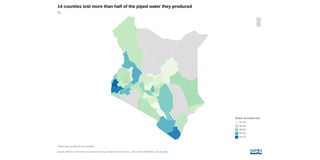Breaking News: CDF Francis Ogolla involved in KDF chopper crash
Getting it right on water can fix health and economy

Kenya will become healthy and prosperous faster if the country accelerates the pace towards universal access to clean water, shows a NationNewsplex review of key data on water, health and development.
Depressed water supply has been linked to economic and health challenges. An estimated four out of five jobs are water-dependent globally, with sectors that rely heavily on water including agriculture, forestry, inland fisheries and aquaculture, mining and resource extraction, power generation and manufacturing, according to the Word Water Assessment Programme.
The manufacturing sector, for instance, is one of the country’s leading employers but has been receiving a beating lately due to high cost of production driving investors away. Its share of contribution to the Gross Domestic Product (GDP) has steadily fallen for more than five years, standing at eight percent in 2018 from 11 percent in 2013. The suppressed growth in the sector has translated to a meagre two percentage point annual manufacturing jobs growth.
Fixing the water demand and supply gap will reduce production costs and spur investment and job creation in the sector.
In poor urban areas, many employment opportunities such as at construction sites and car wash facilities, and in food kiosks are hampered by water shortage. Besides, the time taken fetching water could be spent in gainful employment or in job search.
The informal sector, the source of 91 percent of new jobs created in 2018, according to the Economic Survey 2019, employs a significant number of people living in the low income urban neighbourhoods, with some of the jobs based in such areas. Sufficient and reliable water supply to such areas will therefore promote production and employment.
Healthy economy
The World Health Organization (WHO) estimates that sub-Saharan Africa loses an equivalent of four percent of its GDP as a result of inadequate water supply and sanitation. Part of this is made up of the heavy disease burden occasioned by diseases linked to water and sanitation challenges. In 2017 there were 1.2 million outpatient visits in Kenya involving children under five who suffered from diarrhoea-related illnesses which in most cases are directly linked to dirty water, inadequate toilets and poor hygiene, according to the Statistical Abstract 2018. Unicef reports that in 2016, some 5,107 similar cases in Kenya ended up in deaths.
In Soweto-Kayole, a low income settlement in Nairobi that experiences acute water shortage, diarrhoea is a permanent ailment. The In-Charge at Soweto Health Center, a community facility supported by the Government and Non-Governmental Organisations, Stephen Vengi, says they receive between 16 and 20 diarrhoea cases every week mainly of children of ages three to seven, all of which they attend to, save for two to three severe conditions that they refer to Mama Lucy Hospital in Umoja 3 estate. “Running piped water is the best way out here because poor families lack the capacity to store water safely. Many of the cases we handle are as a result of people consuming contaminated water,” he says.
Like their clients, their water story is not a pleasant one either. Every week a tanker delivers to them 2,000 litres of water at Sh5,000. Though they try to augment this with what they get from their rain water harvesting system, the shortage has seen them operate at 60 percent efficiency, a situation that worsens during dry seasons.
Universal access to safe drinking water and adequate sanitation and hygiene would reduce the global disease burden by up to 10 percent, according to WHO.
Kenya has an ambitious national water master plan with 2030 targets. It also has its eye on the Sustainable Development Goal number six, on clean water and sanitation. To achieve these, the country needs to double efforts in the management of water resources. So far, Kenya scores 52 percent in implementation of integrated water resources management as a component of SDG -6, indicating a lot still needs to be done.




